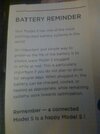After reading an interesting article on InsideEVs about battery capacity loss in cold weather, I went to the Recurrent website ( Winter & Cold Weather EV Range Loss in 7,000 Cars ) to get more information. I was surprised to see that my Model S 75D had TERRIBLE cold-weather performance, achieving only 35% of the rated EPA range at 25F, which is a normal high for folks in Michigan during January and February.
This got me to thinking about when I removed the frunk 'container' and saw all the rubber hoses that snaked around under it. It also reminded me of a post where someone in Canada bought and installed a 'sheet' of insulation for the bottom of their battery pack each winter (but now I cannot find it).
Given the fact that I do have battery degradation (now only seeing 227 miles @100%), and that I live in cold climate state, I would like to see if I can do anything to reduce the loss. Has anyone successfully done any insulation on older models?
This got me to thinking about when I removed the frunk 'container' and saw all the rubber hoses that snaked around under it. It also reminded me of a post where someone in Canada bought and installed a 'sheet' of insulation for the bottom of their battery pack each winter (but now I cannot find it).
Given the fact that I do have battery degradation (now only seeing 227 miles @100%), and that I live in cold climate state, I would like to see if I can do anything to reduce the loss. Has anyone successfully done any insulation on older models?



